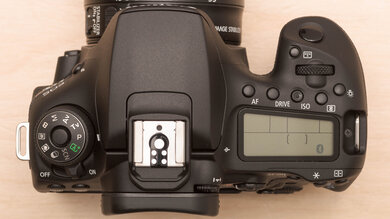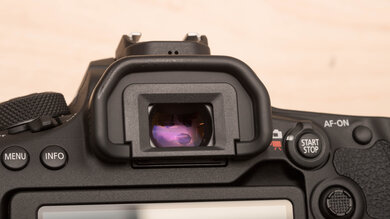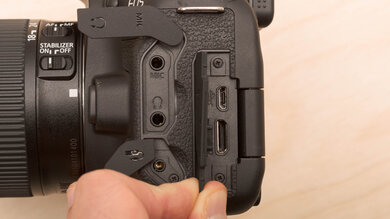The Canon EOS 90D is a versatile APS-C DSLR camera. It takes sharp, clear images with a relatively high dynamic range and little noise, even at high ISO settings. It's also equipped with an autofocus system that delivers very good performance in photography and does a remarkable job of tracking and maintaining focus on subjects in 4k and FHD video. It's comfortable to operate and has a well-laid-out menu system that's easy to navigate. Unfortunately, it's quite bulky and does poorly smoothing out camera shake while recording.
Our Verdict
The Canon 90D is good for travel photography if you don't mind a bulkier kit. Image quality is very good overall. Though it doesn't have the best noise handling in low light, you can still get great results. Its autofocus system is also reasonably quick, reliable, and consistent, and it has sufficient battery life to last you throughout extended shooting sessions. Unfortunately, it's quite bulky, which can make it a hassle to carry around, though it's comfortable to use.
-
Comfortable to use.
-
Good overall image quality.
-
Good autofocus performance in photography.
-
Excellent battery life.
-
Bulky construction.
-
Some controls feel a little sluggish.
-
Image sharpness can decrease at high ISO levels.
The Canon 90D is decent for landscape photography. It offers good overall image quality with a relatively wide dynamic range, though it isn't the best low-light option, depending on your lens. Also, its fully articulated screen is easy to see even under direct sunlight. It feels quite comfortable to use and has a weather-sealed construction. Unfortunately, some of its controls feel slightly sluggish, and the camera's bulky design can make it challenging to carry around for extended periods.
-
Comfortable to use.
-
Good overall image quality.
-
Brightly-lit fully articulated touchscreen interface.
-
Bulky construction.
-
Some controls feel a little sluggish.
-
Image sharpness can decrease at high ISO levels.
The Canon 90D is a good option for sports and wildlife photography. Image quality is good overall, and its decently high maximum shooting speed, combined with its fast maximum shutter speed, make it easy to capture clear images of fast-moving subjects. Its autofocus system also does a good job of acquiring and maintaining focus on faces and objects. It's comfortable to operate, though some of its controls are a little sluggish, and its bulky size can present a bit of an annoyance.
-
Comfortable to use.
-
Good overall image quality.
-
Decently fast maximum continuous shooting speed.
-
Good autofocus performance in photography.
-
Bulky construction.
-
Some controls feel a little sluggish.
-
Image sharpness can decrease at high ISO levels.
The Canon 90D has decent RAW image quality. Its dynamic range is good, so it captures a fair range of detail and is pretty well-suited to high-contrast scenes for an APS-C sensor. Its high-resolution sensor also captures a good level of fine detail, even when punching in. It doesn't have the best noise handling in low light.
-
Good dynamic range.
-
High-resolution sensor.
-
Noise handling is just okay.
The Canon 90D isn't meant for on-the-go vlogging. While it's quite heavy and bulky, it does have a fully articulated screen that allows you to monitor what's being recorded even when the camera is facing you. Video quality in 4k is sharp and clear, though it performs slightly worse in FHD. Its autofocus system does an excellent job of acquiring and maintaining focus on faces. However, it can struggle to smooth out camera shake while recording handheld video.
-
Fantastic autofocus performance while recording video.
-
Brightly-lit fully articulated touchscreen interface.
-
Bulky construction.
-
Poor video stabilization performance.
The Canon 90D is good for studio video work. Video quality in 4k is good, with sharply rendered object edges and surfaces and decent visual noise handling capability. FHD recording quality is slightly inferior, though still okay overall. Its autofocus system does an exceptional job of tracking moving subjects, too. The menu system is easy to navigate while the camera itself features a wide range of inputs for accessories, including a clean HDMI output for using an external recorder without any overlays, as well as headphone and microphone jacks.
-
Easy to use menu system.
-
Fantastic autofocus performance while recording video.
-
Wide selection of ports and inputs.
-
Lack of very high-speed frame rate recording options.
The Canon 90D isn't designed for action video. It's too big and bulky to be mounted on a chest or a helmet rig and struggles to smooth out camera shake in handheld video. It's also incapable of recording at high frame rates in 4k or FHD for generating smooth slow-motion video. On the plus side, its construction is rated as being weather-sealed.
-
Weather-sealed construction.
-
Bulky construction.
-
Poor video stabilization performance.
-
Lack of very high-speed frame rate recording options.
- 7.5 Travel Photography
- 7.3 Landscape Photography
- 7.9 Sport & Wildlife Photography
- 7.4 Raw Photo Performance
- 7.3 Vlogging
- 8.2 Studio Video
- 4.1 Action Video
Changelog
- Updated Jan 29, 2024: Added text to the 'Raw Photo Performance' verdict box and updated existing verdict boxes for clarity and accuracy.
- Updated Jan 29, 2024: Converted to Test Bench 0.12.1.
- Updated Apr 24, 2023: Converted to Test Bench 0.12.
- Updated Apr 12, 2023: Converted to Test Bench 0.11.
- Updated Apr 05, 2023: Added a link to the Canon EOS R7 in the 'Photo Shooting Speed' section.
Check Price
Differences Between Sizes And Variants
The Canon 90D is only available in one color variant: 'Black', and you can see its label here. We tested it in conjunction with the Canon EF-S 18–55mm f/3.5–5.6 IS STM lens, but it can be purchased with other EF and EF-S mount lenses, including the Canon EF-S 18-135 IS USM lens, though we haven't tested it in any other configuration. It can also be purchased without a lens at all.
If you come across a different variant, let us know in the discussions so we can update our review.
Compared To Other Cameras
The Canon EOS R7 is better overall than the Canon EOS 90D, but they use different camera technologies. The R7 is a mirrorless model, so it has the advantage of being a bit more portable and has a newer, more advanced autofocus system. Unlike the 90D, it includes in-body image stabilization, more advanced video specs, and dual SD card slots. The 90D, on the other hand, is a DSLR, so it has a much better battery life and a more established lens ecosystem.
While these are both premium Canon DSLRs, they're differently classed. The Canon EOS 5D Mark IV is a professional-grade camera with a larger, sturdier build and a full-frame sensor, whereas the Canon EOS 90D is a mid-range camera with an APS-C sensor. The 5D Mark IV is overkill for most people, especially considering its size and weight. Because the 90D is a newer model, it offers a few advantages in areas like battery life, autofocus performance, and burst speed.
The Canon EOS 90D and the Canon EOS R10 are both great mid-range cameras, but each has its own advantages. The R10 is more portable and has a more effective overall autofocus system, faster burst shooting, and better video features. In contrast, the 90D has a higher-resolution sensor, a longer battery life, weather-sealing, and a more established lens ecosystem.
The Canon EOS 6D Mark II and the Canon EOS 90D are both great DSLRs but have different-sized sensors. The 6D Mark II is an entry-level pro camera with a full-frame sensor, while the 90D is a mid-range model with an APS-C sensor. Depending on your needs, one may suit you better than the other. If you need full-frame image quality and don't need extras like 4k video capability, go with the 6D Mark II. On the other hand, the 90D is better suited to faster subjects like sports and wildlife, thanks to its faster burst rate, more effective autofocus system, and smaller, higher-resolution sensor.
The Canon EOS 90D and the Canon EOS R8 are different camera types with different-sized sensors, so each has its own advantages. The 90D is less portable than the R8, but it's better constructed, with a weather-sealed body and a longer battery life. It also uses a higher-resolution but smaller APS-C sensor, making it a bit better suited to uses like wildlife photography. The R8, on the other hand, is more lightweight and has significantly better video features, making it a better option for hybrid shooters.
The Canon EOS 90D is better than the Canon EOS Rebel T8i/850D, which isn't surprising, as it sits at a higher price point. It's a better-built camera, with weather-sealing and slightly better ergonomics. It also has a higher-resolution sensor, faster burst shooting, and a longer battery life.
The Nikon D780 is better overall than the Canon EOS 90D, but they're aimed at people with different experience levels. The Canon is a mid-range DSLR with an APS-C sensor, while the Nikon is an enthusiast-grade DSLR with a full-frame sensor. The Nikon performs better in low light and has a more versatile hybrid autofocus system that tracks subjects a little more reliably for photography. It also has a second SD card slot and a longer battery life. The Canon is more portable, has a fully articulated screen, and shoots at a faster max burst rate.
While they use different-sized sensors and different camera technologies, the Canon EOS R6 is better overall than the Canon EOS 90D. It's a more well-rounded model, with a better autofocus system and better video features than the 90D, which is an older mid-range DSLR with a smaller APS-C sensor. The longer battery life, smaller but higher-resolution sensor, and more established lens ecosystem of the 90D do make it a good fit for things like wildlife photography or landscapes. However, we still recommend the more modern R6 for most uses.
The Canon EOS 90D and the Sony α7 III are different types of cameras. The Canon is a mid-range APS-C DSLR, whereas the Sony is a hybrid full-frame camera. The Canon is a good option for wildlife photography thanks to its high-resolution APS-C sensor and for those who prioritize battery life and ergonomics. However, the Sony camera is better overall for hybrid and video shooters, with better video capabilities, a more intuitive overall autofocus system, and better noise handling in low light.
Test Results
- Rubber eyecup around the viewfinder feels comfortable
- Hand grip should accommodate a wide variety of hand sizes, without fingers getting pinched between the body and lens
- Hand grip has a textured surface that provides a secure hold
- Backrest is sufficiently large for most finger sizes
- Dedicated controls for aperture, shutter speed, and ISO make it easy to change exposure settings quickly
- SD card can be accessed while the camera is on a tripod due to the side-opening door
If you want a camera with a faster max burst rate, consider the Canon EOS R7.































































